May 12, 2014 | base metals, cents, coins, nickels, RCM, Royal Mint, US Mint
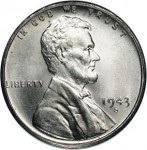
U.S. cents have been made of copper, steel, and copper plated zinc. What’s next?
Although the U.S. Mint does not define who they consider stakeholders but does mention the “coin industry” in one paragraph, the guideline questions are clearly targeted to the coin-operated machine industry. Coin-op machines are more than the soda and candy machines that may be in the break room where you work. These machines include toll booth machines, machines that produce bus and/or train fare cards, parking meters, game machines, and even the few pay telephones that are still in use. Everything that accepts coins will have to be replaced, repaired, adjusted, or scrapped should there be a change in coinage metals.
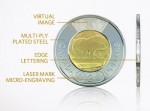
The new technology used by the Royal Canadian Mint to protect the Toonie (C$2)
In the United Kingdom, the Bank of England and law enforcement is engaged in a difficult fight against counterfeit £1 coins. Sources estimate that between 3-percent of the £1 coins in circulation are fake amounting to more than 45 million counterfeit coins. These fakes are so convincing and very well constructed that they can be successfully used in vending machines for payment including in London’s Underground. In an attempt to stem the problem, the Royal Mint has designed a new £1 coin to be circulated by 2017 in hopes to cut the counterfeiting rate.

New edge view of the coin the Royal Mint hopes will be able to thwart counterfeiters.
The coin-operated businesses in Britain are beginning to complain about the changes even though they are being given nearly three years to adjust. For their systems, the new coins will have a different weight, specific gravity, and the electromagnetic signature will differ from the current coin. Every system from the Underground to parking systems to food and beverage vending machines will have to be upgraded to accept the new coins. One report estimates that it will cost up to £50 million (approximately $82.3 million) just to update parking systems.
The Automatic Vending Association, the U.K.’s vending industry trade group, estimates that the new coin will costs its members over £100 million ($168.5 million) to convert their machines.
Expect the costs in the United States to be much higher mainly because of scale. The National Automatic Merchandising Association (NAMA), the $45 billion per year vending industry trade association in the United States, has already issued a report saying that it will cost from $100 to $500 per machine to convert them to accept new coinage.
The American Amusement Machine Association (AAMA) has come out against any change in U.S. coinage. It was reported that AAMA president John Schultz said to leave the coinage alone “because it works, rather than risk the costly consequences.” AAMA has not provided an estimate for those costly consequences.
The last significant change in coinage composition was in 2000 on the introduction of the Sacagawea “Golden” dollar coin. Following the debacle of the Susan B. Anthony small dollar coin that was mistaken for a quarter, the coin was redesigned without a reeded edge and given a golden color by adding manganese to the metals mix. Although this change primarily impacted the gaming industry that relied on the dollar coin, the vending machine industry did respond by converting old machines and manufacturing new ones that accepted the new coin.

The change to copper-coated zinc cents created a seven coin set for 1982
Any discussion of coin composition changes has to include the change from silver to clad coinage. When President Lyndon B. Johnson signed the Coinage Act of 1965 (Pub. L. 89-81) into law on July 23, 1965, the composition of the dime and quarter dollar was change from 90-percent silver and 10-copper to 75-percent copper and 25-percent nickel bonded to a core of pure copper. This mix of metals was selected so that the coins would have an electromagnetic signature that was very similar to their silver counterparts. The half-dollar was reduced to 40-percent silver surrounding a pure copper core.
This change in coinage was done for the same reason that congress has asked the U.S. Mint to study alternative metals: the cost of materials and labor to make the coins is higher than the face value of the coin. As of the Fiscal Year 2013 (October 2012-September 2013) Annual Report, it costs the U.S. Mint 1.83 cents in labor and materials to manufacture the one cent coin and 9.41 cents for the five cents coin.
As a comparison, the cost for the dime including labor and materials is 4.56 cents per coin while the quarter dollar costs 10.5 cents to make.
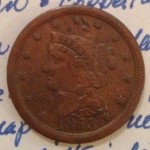
1853 Braided Hair Half Cent Obverse – The last lowest denomination coin eliminated by the congress.
- Does the U.S. eliminate the one cent coin?
- Does the U.S. eliminate the one dollar note in favor of a coin?
- If a transition to new metals is approved, does the government provide economic assistance to small businesses and sectors that will feel a bigger impact from this change?
- Will the federal government provide assistance to communities to help convert municipal services to be able to take the new coins?
- Should the U.S. Mint, a government agency, be allowed and/or required to earn a profit from its operations?
- How will the people be educated on the new coinage?
- What role will the Federal Reserve play?
Since the U.S. Mint did not define who their stakeholders are, it is fair to say that the stakeholders are all citizens of the United States. If you would like to comment, the U.S. Mint is looking for input on the following factors:
Costs to convert to circulating coins composed of alternative metals given the following possible changes to coins:
- Weight
- Electromagnetic signature
- Visual changes, such as color and relief
Transition time needed to introduce a circulating coin composed of an alternative metal.
Comments on how best to inform and educate both affected industries and the public on changes to circulating coins.
Environmental impact from the use of circulating coins composed of alternative metals.
Other issues of importance not identified above.
When commenting, note that the U.S. Mint said it is not considering aluminum alloy metals.
Responses are due to the U.S. Mint 60-days following its printing in the Federal Register (April 10, 2014 making the due date June 9, 2014). Electronic comments can be sent to Coin.StakeholdersResponse@usmint.treas.gov. If you prefer to send your comments the traditional way, mail them to Coin Stakeholders Response, Office of Coin Studies, United States Mint, 801 9th Street NW., Washington, DC 20220.
If you do comment and would like to share what you said with the rest of the community, either send it to me via email or post it as a comment below.
Photo credits: All photographs are the author’s except the image of the Toonie from the Royal Canadian Mint and the One-pound coin prototype from the Royal Mint.
Dec 29, 2013 | Canada, coins, counterfeit, legislative, RCM
Counterfeiting coins and currency has been a problem for both the government and the numismatic industry. Government has shown it will go to extensive lengths in order to change the $100 note in order to stop currency counterfeiting. In fact, currency has had a long history of trying to fight currency counterfeiting.
For collectors of United States coins, there is a problems with the counterfeiting of classic coins primarily from China. In China, it is legal to reproduce obsolete

An example of a Morgan Dollar cut in half to match a date with a mintmark to have the coin appear something it is not. Coin was in a counterfeit PCGS slab and caught by one of their graders.
Those who create counterfeit coins are not making “tributes,” as has been the stance of the Chinese government. They are reproducing rarities and trying to pass them as real coins. In some cases, these counterfeiters are even trying reproduce the third-party grading service slabs in order to get them past scrutiny.
In the United States, Industry Council for Tangible Assets and the Gold & Silver Political Action Committee has been working to have congress update the Hobby Protection Act (15 U.S.C §§ 2101-2106) to provide for more protection to the buyer. Aside from strengthening the requirement to have copies appropriately marked and marketed, it allows for duped buyers and the government to take action against the resellers. Currently, the Hobby Protection Act only allows for action against the manufacturers and not anyone else in the supply chain. By opening the supply chain to prosecution it is hoped that it will choke off the supply.
This past August, the House of Representatives passed the Collectible Coin Protection Act on a unanimous voice vote.
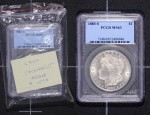
PCGS representatives showed Congressmen counterfeit U.S. coins in counterfeit PCGS holders during their recent meetings in Washington, DC. (Photo courtesy of PCGS.)
Collectible coins are not the only problem. Great Britain has been having problems since the issue of new £1 coins entering circulation starting in 2010. Even though arrests have been made, there remains an undetermined amount of counterfeit coins in circulation.
Last summer, counterfeiters were arrested in Greece and Turkey for producing fake 2 Euro coins. These counterfeits look very similar to the standard 2 Euro coin with the standard Greece reverse. A real 2 Euro coin is a bi-metalic coin that does not separate. The counterfeits will separate and are lighter than the real version.
In Canada, the Royal Canadian Mint has changed the Loonie and Toonie to include micro engraving to thwart counterfeiters. The RCM has also changed the composition of the coins which will help them last longer.
Counterfeit coins and currency will continue to be a problem. Every change, no matter how small, is not only good for the economy, it is good for the hobby.
-
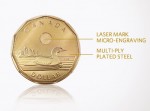
-
The new technology used by the Royal Canadian Mint to protect the Loonie ($)
-

-
The new technology used by the Royal Canadian Mint to protect the Toonie (C$2)
Nov 29, 2012 | coins, commentary, dollar, legislative, news, RCM, US Mint
Starting with a blog post on the Wall Street Journal website, the interwebs were all a twitter about the a testimony statement published in advance of the “The Future of Money: Dollars and Sense” hearing before the House of Representatives Subcommittee on Domestic Monetary Policy and Technology November 29, 2012.
The testimony is by Lorelei St. James, Director, Physical Infrastructure Issues of the non-partisan Government Accountability Office. The testimony report, “Benefits and Considerations for Replacing the $1 Note with a $1 Coin,” reiterates the six previous GAO reports claiming large savings by replacing the paper dollar with a coin. This is not a new stance by the GAO. They have issued six reports since 1990 making the same recommendation with the last report (GAO-12-307) released on February 15, 2012—something I wrote about here.
Rather than concentrating on the redux of the GAO’s statements, the media missed the advance statement from Beverley Lepin, Chief Operating officer of the Royal Canadian Mint. In her testimony, Lepin will point out how the RCM changed alloys twice, has a coin recycling program, added color, and has anti-counterfeiting technology for their one-dollar (Loonie) and two-dollar (Toonie) coins.
Basically, Lepin is saying something only whispered by some: the Royal Canadian Mint is more advanced than the U.S. Mint.
But the problem is not the U.S. Mint’s fault. When it come to running their operation like a business, the RCM has a real business structure that works with the the Bank of Canada and the Parliament of Canada to ensure that their money supply is modern and more efficient. Neither Canada’s parliament nor the Bank of Canada micro-manages the RCM’s operations the way congress micro-manages the U.S. Mint.
I know that Article I, Section 8 of the United States Constitution says that “The Congress shall have Power… To coin Money, regulate the Value thereof, …” but it does not say that congress shall have the power to micro-manage the U.S. Mint to the point where it is running using rules that have been made as long as 220 year ago. Maybe it is time to learn the real lessons from the RCM and modernize the structure of the U.S. Mint.
Before some strict constitutionalist or ardent supporter of congress accuse me of trying to usurp congress’s powers, let me remind you that Article I, Section 8 also grants congress the power “To establish Post Offices and post Roads.” The last time I looked, the United States Postal Service is an independent organization that establishes and closes post offices and it has been over 50 years since the last time a “post Road” has been built.
I do not expect anything to happen as a result of this hearing except for verbal fireworks from the politicians, overly excited sound-bites from the cable news talking heads, and incorrect information from the print media—which we will correct here, of course. I will just sit back and enjoy the show of the last hearing of this type held by a Ron Paul-lead subcommittee.
GAO Reports
The following is a list of the reports and testimonies from the Government Accountability Office about replacing the one-dollar note with a one-dollar coin:
- National Coinage Proposals: Limited Public Demand for New Dollar Coin or Elimination of Pennies, GAO/GGD-90-88, May 23, 1990
- 1-Dollar Coin: Reintroduction Could Save Millions If Properly Managed, GAO/GGD-93-56, March 11, 1993
- Dollar Coin Could Save Millions, GAO/T-GGD-95-203, July 13, 1995
- Financial Impact of Issuing the New $1 Coin, GAO/GGD-00-111R, April 7, 2000
- U.S. Coins: Replacing the $1 Note with a $1 Coin Would Provide a Financial Benefit to the Government, GAO-11-281, March 4, 2011
- U.S. Coins: Alternate Scenarios Suggest Different Benefits and Losses from Replacing the $1 Note with a $1 Coin), GAO-12-307, February 15, 2012
- U.S. Coins: Benefits and Considerations for Replacing the $1 Note with a $1 Coin, GAO-13-164T, November 29, 2012
Jul 7, 2010 | coins, currency, Euro, foreign, gold, RCM, video
Not all coin news comes from the United States. Here are three interesting non-U.S. stories from the last few weeks:
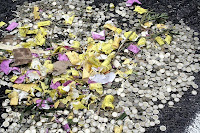 Foggia, Italy—A truck in southern Italy carrying €2 million in one and two euro coins crashed and spilled its load on the highway. Feeling they hit the jackpot, drivers stopped and started to scoop up the coins. On the scene, it was estimated that €10,000 was taken. A later count upped that estimate to €50,000. No arrests were reported.
Foggia, Italy—A truck in southern Italy carrying €2 million in one and two euro coins crashed and spilled its load on the highway. Feeling they hit the jackpot, drivers stopped and started to scoop up the coins. On the scene, it was estimated that €10,000 was taken. A later count upped that estimate to €50,000. No arrests were reported.
Driver of the truck and the two cars in the accident were not seriously injured, but they were not the focus of many of the stories. With coins strewn on the roadway and the median, the company responsible for the transport of the coins will be spending the next few days trying to sweep up the coins that motorists did not take.
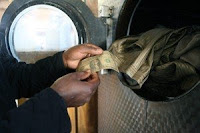 Zimbabwe—In a country where runaway inflation caused their currency to become worthless and the government made U.S. currency legal tender, Zimbabweans are washing their U.S. dollars so that they can be used.
Zimbabwe—In a country where runaway inflation caused their currency to become worthless and the government made U.S. currency legal tender, Zimbabweans are washing their U.S. dollars so that they can be used.
In this poor country, low-denomination U.S notes are used until they fall apart. But in order to protect currency in crime-ridden areas, notes are carried in shoes or underwear. The obvious sanitary and malodorous issues has made it a problem causing banks and many merchants to refuse to take currency that is dirty and smelly. Some people gently hand-wash their notes and some laundry services have discovered that they can wash notes in the gentle cycle then hang the notes to dry.
Apparently this works for the poor in Zimbabwe since the notes outlive the Bureau of Engraving and Printing’s estimated life span of a $1 Federal Reserve Note of 20-months.
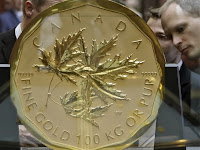 Vienna—Spanish gold dealer Oro Direct S.L.U. bought the world’s largest gold coin at auction for &euro3.27 million (approximately $4.02 million). The 100 kilogram coin with a face value of C$1 million was made by the Royal Canadian Mint in 2007. This coin currently holds the world’s record for being the largest coin ever made.
Vienna—Spanish gold dealer Oro Direct S.L.U. bought the world’s largest gold coin at auction for &euro3.27 million (approximately $4.02 million). The 100 kilogram coin with a face value of C$1 million was made by the Royal Canadian Mint in 2007. This coin currently holds the world’s record for being the largest coin ever made.
Gold was trading at $1,253.55 per troy ounce in London at the time of the auction.
“We believe that this is a way to demonstrate our opinion that gold is the ultimate store of wealth,” Oro Direct spokesman Michael Berger was reported as saying. “As long as central banks continue to print enormous amounts of paper money, we believe physical gold will be a fantastic investment.”
The following news video is from Reuters:
About the coin in a video by the Royal Canadian Mint:
Images from Italy and Zimbabwe are courtesy of the AP.
Image of the C$1 Million Maple Leaf courtesy of Reuters.
Dec 5, 2009 | RCM, Royal Mint, US Mint, web
Progress and experience is a good thing. It helps us learn about ourselves and how other perceive us. In the world of competing for business in numismatics, progress and experience helps those who sell coins and offer services improve how they communicate to us, their customers and constituents. Today, we are going to look at the websites that those of us who live part of our lives online visit for our numismatic fix.
Earlier this year, the Royal Canadian Mint updated their website. Prior to their current update, their site was written using Adobe Flash in a way that felt limiting to someone who visited the site to browse. The updated site has a more exciting look, fresher colors, and is better for those of us who like to browse. And speaking of browsers, this version does not use Flash in the same way as the old site. Your experience will be faster and more responsive than the previous RCM design. It is clear that experience has allowed the RCM to progress to a new design.
Not long ago, The Royal Mint updated their website. Although The Royal Mint did not need an update, they chose to change the basic theme and go with a simple design with a black background. It give the site a regal look, which is in tune with The Royal Mint’s vision of itself as one of the world’s oldest mint. However, navigation of this site is a bit quirky. There appears to be extra clicks required to find products and while the look is nice, every page has an image on top that distracts from the presentation by pushing to coins down. This image may only be a minor annoyance, but an annoyance nonetheless.
Here in the United States, there have been changes in the website for the Bureau of Engraving and Printing. The bureau with one of the best domain names (www.moneyfactory.gov) appears to have hired website designers that have graduated from Web Design 101. The site is is clean and professional looking with easier navigation making it easier to find information about the BEP. From the front page, the site is about the bureau and its functions. Sure, the last major even of the BEP is the redesign of the $5 Federal Reserve Note in 2007, but it allows the BEP to highlight its limited accomplishments.
With the new design, the BEP has created a new store front with its own domain name: www.moneyfactorystore.gov. The new store is easier to navigate and find products. The categories have been cleaned up, the unavailable products have been removed, and the premium series can be purchased by series or individual Federal Reserve banks. Buying individual premium products by Federal Reserve Bank was not possible with the old website.
Moving away from the government, the Professional Coin Grading Service has redesigned its website again. This time, rather than rely on the black and gold theme of their logo, PCGS is using a lighter blue theme to highlight their service. While this design is better than their previous designs, it is not without issue. For example, there is something about the front page layout that bothers me. The banner is too large, there is too much space between the banner and the page contents, and menus at below the main content are too low. If the PCGS web designers can lower the height of the banner, close up that extra space, the lower menus will move up on the page and not feel as if they are an after thought. Making these fixes could change the A- design into a solid Grade A design.
Of course the one website that is in dire need of updating continues to have the same design since 2000. The US Mint should update their web presence, especially their online catalog.
Apr 22, 2009 | fun, gold, RCM, video
Not long ago, a Canadian friend passed along a funny video of a tour of the Royal Canadian Mint. Today, someone else sent the link to the video so I decided to share. The video is by Rick Mercer. Mercer is the host of the popular Rick Mercer Report on Canadian Broadcast Company network. He is a popular political satirist in Canada whose show is described as a cross between something he has done in the past and The Daily Show with Jon Stewart.
In this video, Mercer and his crew visit the RCM’s Ottawa facility to take a tour of the gold storage areas and coin production. Mercer is very irreverent in the video giving his tour guides and nearby guards proverbial heartburn over his antics. See for yourself and enjoy!
Jan 5, 2009 | Canada, coins, RCM
A fascinating aspect of numismatics is to learn how the coins we collect are made. Whenever a television show has a story on the production of coins or currency, I always watch with interest. One show where I have seen an interesting presentation on minting coins is on a show called How It’s Made that is airing on Discovery network’s Science Channel.
For those not familiar with How It’s Made, it shows how various items are manufactured in nicely edited five-minute vignettes. Although the producers find manufacturers all over the world to show how products are made, the show is based in Canada. So rather than try to pierce the veil of the US Mint for the show, they went to the Royal Canadian Mint to show how commemorative coins are made.
Thanks to another How It’s Made fan posting the segment on YouTube, watch how the RCM makes commemorative coins:
On January 9, 2009 at 10:30 PM (EST), the Science Channel will be airing How It’s Made: REMIX, a show where they bring in separate vignettes under one theme. This show features currency. According to their online schedule, the stories planned for this show is change machines, gold, stamps, and collectible coins. Check your local listing to find the Science Channel in your area.
Nov 11, 2008 | history, RCM
On the eleventh hour of the eleventh day of the eleventh month in 1918, the war to end all wars ended. It is celebrated around the world as Armistice Day or Remembrance Sunday. In the United States, a law was passed in 1954 to honor all veterans on November 11 of every year.
There will be the usual celebrations around the nation. Ceremonies will be held at Arlington National Cemetery that will culminate with the laying of a wreath at Tomb of the Unknowns
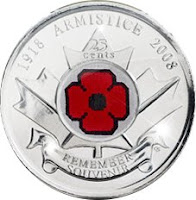 In Canada, the Royal Canadian Mint has reissued the Poppy Circulating Quarter to honor the 90th anniversary of the end of World War I. The poppy became popular in Canada when mentioned in a poem by Canadian Medical Director John McRae in the lime-rich fields of Belgium.
In Canada, the Royal Canadian Mint has reissued the Poppy Circulating Quarter to honor the 90th anniversary of the end of World War I. The poppy became popular in Canada when mentioned in a poem by Canadian Medical Director John McRae in the lime-rich fields of Belgium.
RCM has been distributing these quarters through retail outlets throughout the country along with providing special collectibles on their website. One dollar from the sale of each 2008 Limited Edition Poppy Bookmark will be donated to the Legion’s Dominion Command Poppy Trust Fund, which provides financial aid to Canada’s veterans.
To the veterans of the War to End All Wars and every wars since, thank you for your service to our country!
Image courtesy of the Royal Canadian Mint.
Oct 12, 2008 | cents, RCM
Apparently, the United States is not the only country with a cost problem of its lowest denomination coin. In Canada, the press obtained notes from meetings with the Bank of Canada under the Access to Information Act (a similar law to the US Freedom of Information Act) that shows the Canadian cent costs more than one-cent to produce.
The Canadian cent weighs 2.35 grams and is made from .940 steel, .045 copper, and .015 nickel whose costs are subject to market conditions as any other item made from metals. As the economy changes, not only do the costs of materials change, but the costs of doing business changes. While the Royal Canadian Mint has said that the cent costs .008 to produce, reports based on the newly released documents show that the claim is based on the cost of metals and not production costs.
Accounting for labor and transportation costs from December, 2007, when the report was written, it is estimated that the Canadian cent costs an estimated 1.5-cents to produce. Some Canadian politicians are up in arms over the costs and want to “do something” about this without considering that seignorage from other coins more than covers the cost.
It is interesting to hear that other countries are having the same problems as we are here in the United States.
Oct 8, 2008 | gold, platinum, RCM, silver, US Mint
Showing that the management of the US Mint does not understand how to manage a specialized manufacturing facility, it was reported that the Mint is not going to try to maintain the supply to meet the demand for precious metals. In a letter to authorized dealers, the Mint blames the fluctuating market and high demand for this decision.
For the rest of the year, the Mint will continue to strike gold and platinum coins until supplies of blanks are depleted. The supply of 24-karat Gold Buffaloes have been depleted. Silver and one-ounce gold American Eagles will continue to be available as they can be struck.
Those wanting to purchase gold may want to consider previous years or Canada Gold Maple Leafs. It is being reported that the Royal Canadian Mint continues to strike gold but has been having problems keeping up with the demand. Alex Reeves, a spokesperson with the Royal Canadian Mint, said, “[Distributors] would like more gold than we can produce but we’re supplying the best we can. Look at that as good news. We’re able to keep producing gold while the U.S. Mint has to throw up their hands and say, ‘we’re out.’ ”
Fasten your seat belts, it’s going to be a bumpy ride!













